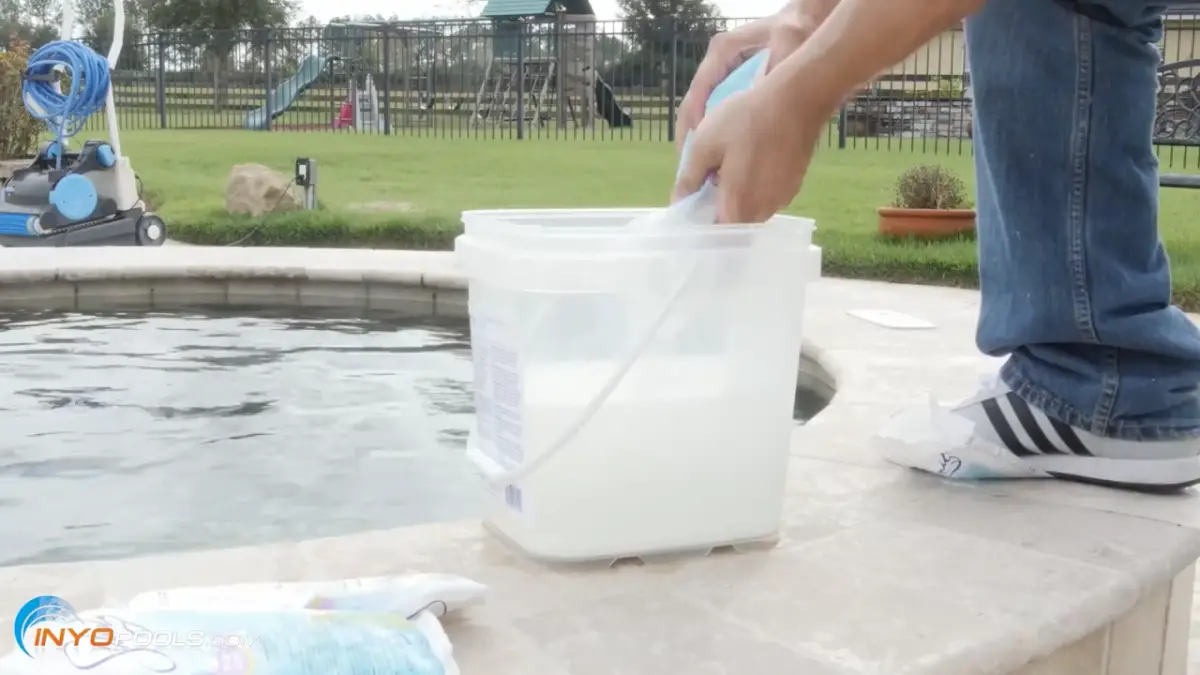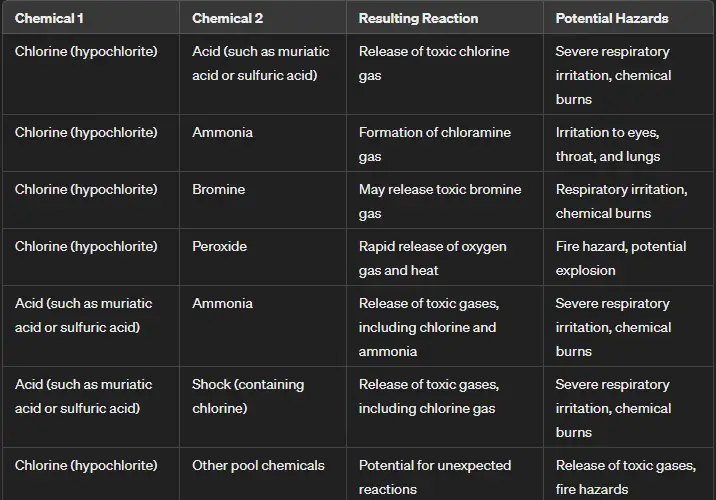When it comes to opening your swimming pool any owner can tell you that your main goal is to get your pool up and going by Memorial Day Weekend which is known as the unofficial first day of summer but when you get the cover off, add water and fire up the filter you are down to the chemicals. You can’t rush it, you could waste money and delay opening. How long do you wait between adding pool chemicals?
- Chlorine & acid: Wait 15-30 mins
- Chlorine & algaecide: Wait 15-30 min
- Chlorine & shock: Wait until Chl level returns to normal
- Cal Hypo & acid: Wait until dissolved
- Cal Hypo & shock: Wait until dispersed
- Shock & algaecide: Wait 15-30 min
- Balancers & Chlorine: Wait 15-30 min
- Balancers & shock: Wait 15-30 min
If you don’t add chemicals to your pool right then the chances the pool water doesn’t react the way it’s supposed to is pretty certain but using some patience and extra testing will keep things coordinated and you open on schedule.
How Long to Wait Between Adding Pool Chemicals
Knowing how long to wait between adding pool chemicals is crucial for several reasons. Firstly, certain chemicals can react with each other if added too closely together, leading to potentially hazardous or ineffective results.
For example, mixing chlorine-based products with acid-based products can release harmful gases. Waiting allows each chemical to fully disperse and react with the water before introducing another, minimizing the risk of adverse reactions.
The wait times between adding pool chemicals is usually around 10 minutes each, as that is also sufficient time for the chemicals to mix in the water. Users also under normal conditions can swim roughly on average about 10 minutes after adding chemicals.
If you turn on your pump on high and pour the chemical slowly in front of the return, you would find that they mix pretty quickly. In the same way, if you turn your pump on low and pour the chemical the wait time will be much longer.
How long the chemical takes to completly work is independent of what the pool chemical is.
Additionally, proper spacing between chemical additions ensures that each one has time to effectively balance and stabilize the pool’s water chemistry. This helps maintain optimal conditions for swimming, prolongs the life of pool equipment, and ensures the safety and comfort of pool users. By following recommended wait times between chemical applications, pool owners can effectively manage water quality and promote a clean, healthy swimming environment.
The wait time between adding chemicals needs to be calculated with different variables depending on the chemical and pool size. Under normal conditions, you will also be able to swim in the water for roughly 30 minutes after chlorine chemicals have been added. If you turn your pool pump on and slowly pour the chemical mix in front of the return, it should be a pretty smooth mix. Right?
Understanding Water Chemistry and Wait Times for Adding Pool Chemicals
Understanding water chemistry and wait times for adding pool chemicals is essential for maintaining a safe and balanced swimming environment. Each pool chemical serves a specific purpose in regulating pH levels, sanitizing the water, and preventing algae growth. However, the timing of chemical additions is critical to avoid adverse reactions and ensure their effectiveness.
By knowing how long to wait between adding different chemicals, pool owners can prevent dangerous chemical reactions and optimize the performance of their pool treatment regimen. This knowledge also helps in achieving and maintaining proper water balance, which is crucial for the health and comfort of swimmers and the longevity of pool equipment.
Ultimately, staying informed about water chemistry and adhering to recommended wait times empowers pool owners to effectively manage their pool’s maintenance and enjoy a clean, safe swimming experience.
If your pool pump is off and you add chemicals, the mixing process will take longer. Try to wait at least 30 minutes between adding chlorine chemicals to your pool. This might be a sufficient amount of time for the chemicals to mix in the water using the pool pump to mix the chemicals in the pool water. Only you can figure this out.
If you shock the pool then you need to wait for at least 8 hours and up to 24 hours after using a chlorine-based shock before you can swim. And you’ll want to retest your water to make sure your chemical levels are within the range of about 5 ppm.
All pool chemicals take their own time to dissolve when added changing the chemistry of the pool water depends on the chemical’s active ingredients or strength the volume of your pool and how much change is desired.
It is typically recommended to wait even longer after adding water-balancing chemicals. What happens if you add pool chemicals too close together? You’ll get false readings that could end up wasting chemicals, time, and money.
The Right Order to Add Pool Chemicals
Properly Adding Pool Chemicals: From Chlorine to Cal Hypo Chemical and Their Wait Time
You should wait 2–4 hours or (one full pump cycle through the filter) to retest from the moment you use water-balancing chemicals in your pool.
- First-calculate the right dosage of the chemical you will use. (You need to know the gallons of your pool and the flow rate of your pool pump)
- Read the directions on the label chemicals need to be diluted before adding to the pool.
- Wait the recommended time according to the directions on the chemical’s label (every chemical is different)
- Patience is key, especially in a bigger volume pool (You may have to add another dose)
If you add chemicals to balance the water after testing, wait for a full cycle from the pool pump to turn over the pool water at least once or even longer before retesting. Use this pool calculator to find the volume of your pool no matter what shape it is and keep this volume that is expressed as gallons with your filtering equipment.Pool Volume Calculator.
Estimating the volume of your pool is one of the first steps of being able to determine the accurate amount of corrective chemicals needed for a given situation keep it handy you’ll need it again. Use the pool calculator for any shape above-ground and inground pools and variable depth pools.
- Chlorinating agents such as Trichlor and Cal Hypo should never be mixed or in the same feeder as this can lead to an explosion. Despite being chlorinating agents, they are incompatible.
- Do not add at the same time or mix muriatic acid and chlorine. Such interaction produces a toxic gas that is dangerous to health even in small amounts.
- A good rule of thumb is to never mix pool chemicals with each other.
- After adding Calcium Hypochlorite a user should always wait 24 hours before adding chemicals that would alter their pH. Adjusting pH or Total alkalinity after adding Calcium Hypochlorite can cause the calcium to temporarily cloud the water.
Waiting Period 10-30 Mins: Ensuring Safety and Balance in Swimming Pools
Maintaining a safe and balanced swimming environment is vital, especially when it comes to storing and adding pool chemicals. The recommended waiting period between adding pool chemicals varies depending on the particular chemical being added to the pool, but in general, it’s best to wait at least 10-30 minutes before moving on to the next step.
This is because pool chemicals need time to properly mix with the pool water and neutralize potential issues. It’s critical to understand how long to wait between each chemical addition to avoid any issues with the pool’s pH, chlorine, and overall chemical balance.
One of the most common pool chemicals pool owners add is chlorine. Chlorine is necessary for keeping the pool water clean and safe to swim in, but it’s important not to add too much at once. When it comes to adding chlorine to your pool, it’s best to wait at least 10-30 minutes before adding any other chemicals.
This helps prevent chlorine from reacting with other chemical reactions in a way that could be harmful. It also gives time for the chlorine levels to stabilize and become effective at killing bacteria and other contaminants in the pool water.
Another important pool chemical is acid, which is used to lower the pH of the pool water. A balanced pH is essential for the effectiveness of the pool’s sanitizer and overall water quality. When adding acid, it’s important to wait even longer before mixing in other chemicals.
This waiting period ensures that the acid is properly distributed throughout the pool and does not interact with other elements, such as calcium, metals, or stabilizers, to create unwanted chemical reactions.
For those with salt or calcium-based pools, it’s important to test the waters for the development of high or low alkalinity levels. Adjusting the alkalinity in your pool is essential for maintaining a disinfection and safe swimming environment. Just like with chlorine and acid, time is needed to adjust water chemistry. it’s necessary to wait 3-4 hours or better wait for one pool water turnover cycle between adding chemicals that affect total alkalinity.
Lastly, shocking your swimming pool is crucial to maintaining it properly. Shocking a pool can help eliminate the build-up of problematic elements, such as algae and bacteria. When administering a shock treatment, it’s important to turn off the pool filter and wait around before turning it back on. Doing this ensures that the shock treatment is evenly distributed and effective, reducing the risk of negative chemical interactions.
When it comes to maintaining and adjusting the balance of your home’s pool, it’s important to understand the need for a waiting period between adding chemicals. This ensures that each added chemical gets ample time to work as intended, and minimizes the chance of unwanted or harmful reactions. By following these guidelines, you’ll help maintain the safety and balance of your swimming pool, making it a fun and healthy experience for all who enjoy it.
Conclusion:
In conclusion, it’s crucial to handle pool chemicals with care and avoid mixing certain chemicals together. Mixing incompatible pool chemicals can lead to hazardous reactions, release toxic gases, cause fires, or even result in explosions. Always follow the manufacturer’s instructions, wear appropriate protective gear, and ensure proper ventilation when adding chemicals to your pool. When in doubt, consult a professional pool technician to ensure the safe and proper maintenance of your pool.
How long does it take for pool chemicals to work?
How fast Pool Chemicals work is dependent on the size of the pool, the pumping rate of the filter system & how much chemical is needed.
Alkalinity takes 6-8 hrs. or a full turnover of the pool water
PH is 4-6 hours.
Shock Chlorine- at least 30 min.
Cyanuric Acid- one full turnover ……………………………………………………………….. Read more

References:
Test Your Own Pool- How Long Do You Need to Wait Between Adding Pool Chemicals?
Pool Service Gilbert-HOW LONG TO WAIT BETWEEN ADDING POOL CHEMICALS
FAQ’s

